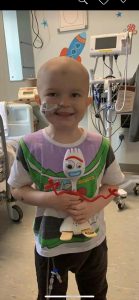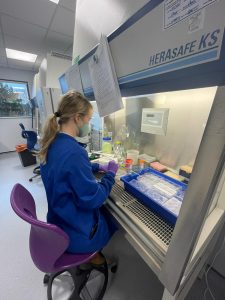Sadly, more than 10 children are diagnosed with cancer in the UK every day. One of the most common childhood cancers is neuroblastoma.┬Ā┬ĀOur ground-breaking immunotherapy trials are giving new hope to these children and their families.┬Ā Dr Juliet Gray , Associate Professor in Paediatric Oncology at the University, is leading new UK immunotherapy studies which are looking at improving neuroblastoma treatments and their effectiveness. Dr Gray answers key questions on this aggressive childhood cancer, the difference immunotherapy trials are making and what the future holds.
What is neuroblastoma?
Neuroblastoma is a childhood cancer that originates from developing nerve cells. It usually starts as a tumour in the abdomen or chest, but often spreads to other places such as the bones. Most children with neuroblastoma are very young, usually under 5 years of age. It is one of the more common childhood cancers and is diagnosed in around 100 children a year in the UK. Over half of these children have an advanced tumour, which has spread by the time of diagnosis.
What are the traditional treatments for neuroblastoma and what is the prognosis?
Treatment depends on whether the disease has spread as well as a number of other risk factors. The majority of children have ŌĆśhigh riskŌĆÖ disease and require intensive treatment. This typically involves intensive chemotherapy, surgery, stem cell transplant and radiotherapy. Treatment lasts at about 18 months, during which children spend a significant amount of time in hospital. Side effects are considerable, and many children are left with long-term effects of their treatment, such as hearing problems and poor kidney function. With traditional therapies, prognosis for high-risk neuroblastoma is poor, with only 30-40% of children surviving in the long term.

What is immunotherapy and how is this new treatment giving hope to patients with advanced neuroblastoma?
Immunotherapy works on the principle that cancer cells have different proteins on their surface compared to normal healthy cells. However cancer cells are clever and are often able to hide these differences from the immune system, allowing the cancer cells to carry on growing. Immunotherapy helps the immune system recognise these differences, enabling it to specifically target and kill the cancer cells. This is potentially a very powerful way of killing cancers cells and provides a much more specific treatment than traditional therapies.
There are a number of different types of immunotherapy, which use different components of the immune system. Some use antibodies, which are the proteins of the immune system which recognise and help remove foreign objects such as bacteria and viruses from the body. Others focus on the cells of the immune system. Lots of different types of immunotherapy are being explored for neuroblastoma. So far, antibody therapies have been most widely used and have shown the most promise.
Parents of children with neuroblastoma understand that even if the tumour shrinks and responds well to initial treatment, there is a very high chance that there will be tumour cells left behind which will subsequently result in relapse. Immunotherapy offer the hope of eliminating any residual cells and reducing the chances of the disease coming back.
Jack Blight, Woody's Dad,It was incredible. When we started the trial, Woody had six cancer spots in his legs ŌĆō after a few weeks they were almost gone.
Can you explain more about immunotherapy trials and what success these are having with neuroblastoma?
An immunotherapy trial is when new immunotherapies that have shown promise in the laboratory are tested in patients with cancer. Sometimes this means testing a brand new immunotherapy for the first time in patients, and sometimes it means testing an existing immunotherapy in patients with a different type of cancer, or testing in combination with other therapies to try and improve the effects.
In 2010, a large clinical trial in the US reported a 20% improvement in survival in children with high-risk neuroblastoma who received an antibody targeting the GD2 molecule on neuroblastoma, in addition to traditional treatment. Since this exciting breakthrough, all children in the UK with high-risk neuroblastoma are given this antibody therapy as a standard part of their treatment. However, many children still have neuroblastoma that relapses or doesnŌĆÖt respond completely to treatment, and a lot of the clinical work in the UK and Europe has subsequently focused on trying to improve this type of immunotherapy, to cure more children.
The team at Southampton have had a key roles in a number of immunotherapy trials aiming to make anti-GD2 more effective and also to reduce the side effects for children.
In particular, I┬Ā have led two different trials which are aiming to improve how effectively anti-GD2 immunotherapy works by combining it with other drugs.
The first of these trials ŌĆśBEACON ImmunoŌĆÖ, looked a giving the anti-GD2 with chemotherapy to patients with neuroblastoma that had relapsed or had not responded adequately to standard treatments. Initial results from the trial showed twice as many children responded to chemotherapy when it was given with anti-GD2. A new trial ŌĆśBEACON 2ŌĆÖ is being developed to confirm this and to try and improve the combination further.
Secondly, the MINivAN trial, which is investigating combining anti-GD2 with a special form of targeted radiotherapy (131-I mIBG) as well as with a second antibody (anti-PD-1). ┬ĀThis is based on results from the laboratory suggesting that both of these may enhance the way in which anti-GD2 kills neuroblastoma cells and hopefully generates long term immunity to the tumour. ┬ĀThis is being done in collaboration with colleagues in the US and Germany. It is one of the first transatlantic neuroblastoma trials and Southampton is leading the trial internationally. ┬ĀPatients from across the UK have travelled to Southampton to take part in the trial.

What does the future hold for immunotherapy and the cure for cancer?
A number of immunotherapies have shown considerable promise in the last few years, and have been adopted as standard cancer therapies. Improvement will now come from improving and fine- tuning individual therapies, but probably more importantly, working out how they can best be combined, either with other immunotherapies or with standard therapies such as radiotherapy and chemotherapy.┬Ā┬Ā There are already a number of trials which have shown really promising results from giving combinations of different antibodies together. The possibilities for future studies combining antibodies with cancer vaccines or cellular therapies is huge, and is only just beginning to be explored.

How do you feel about recent developments and what motivates you in your role at the University?
This is an extremely exciting time for scientists working in cancer immunology. For decades cancer immunologists have believed that the immune system offers a highly specific way of killing and eliminating cancer cells from the body, and a huge number of different immunotherapies have looked very promising in the lab. In the last decade that we have begun to see really positive and exciting results come out of clinical trials, with large numbers of patients now benefiting from immunotherapies.
My motivation for research and new clinical trials comes from the patients that I see, and the need to find new and better treatments for the cancers that they have. Survival rates for many childhood cancers have improved considerably over the last decades with the use of intensive chemotherapy regimens. However for some tumours, such as neuroblastoma, cure rates remain low despite very intensive treatments. Anti-GD2 immunotherapy has already been shown to improve survival for these children, but there is still a lot of work to be done to improve survival rates further. I hope the trials I am involved in can build on what has already been achieved, and deliver more effective immunotherapies.
Juliet Gray ,New and different types of therapy are needed to improve survival rates for these children.